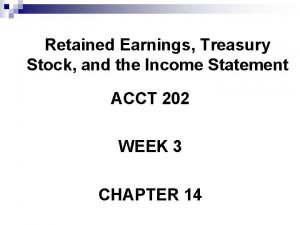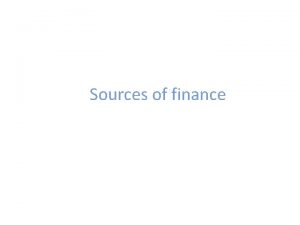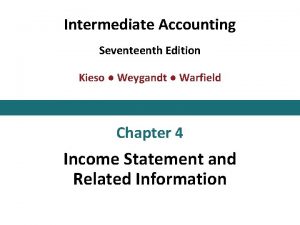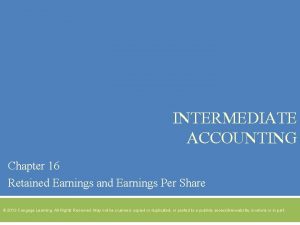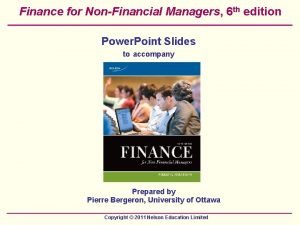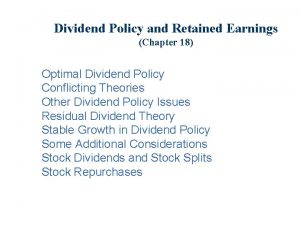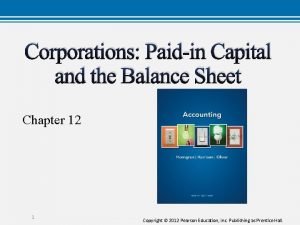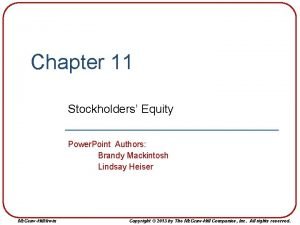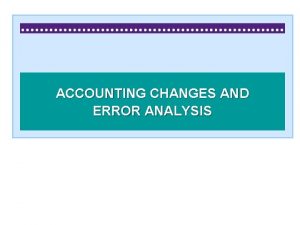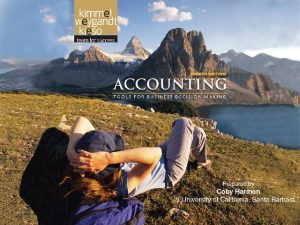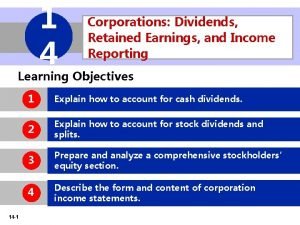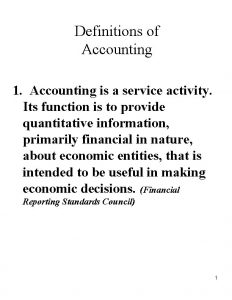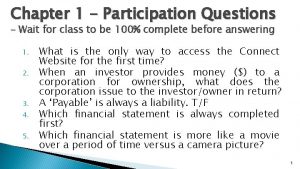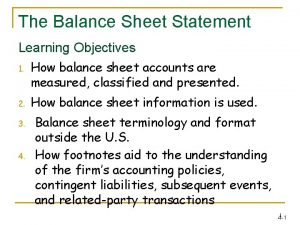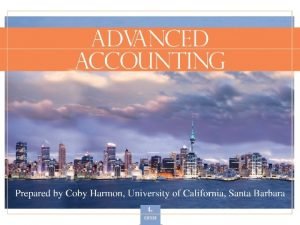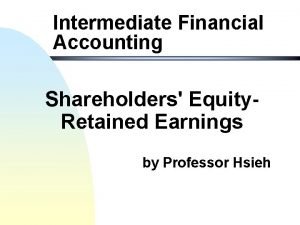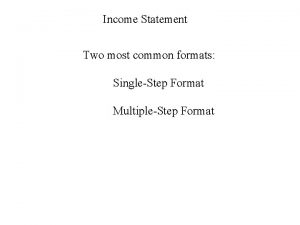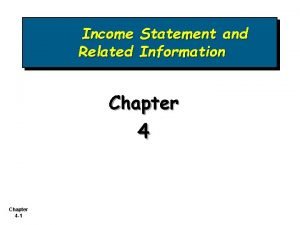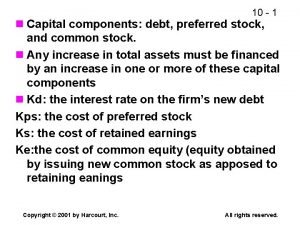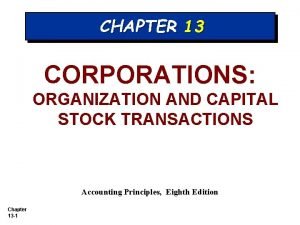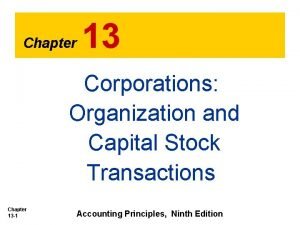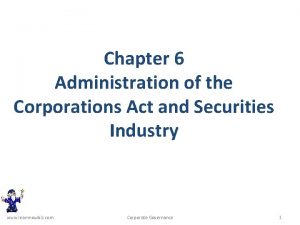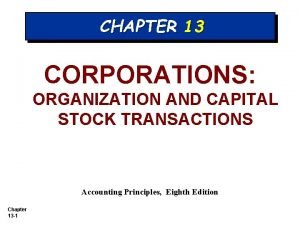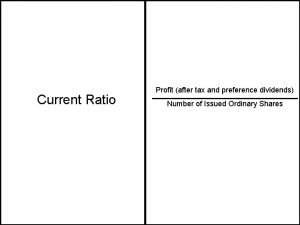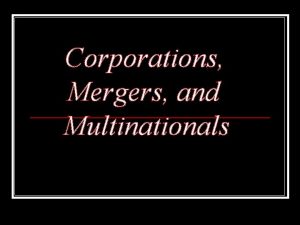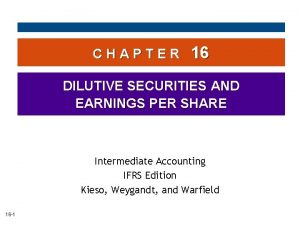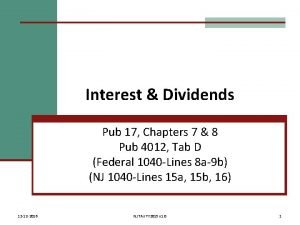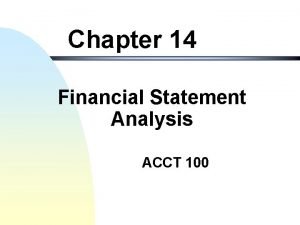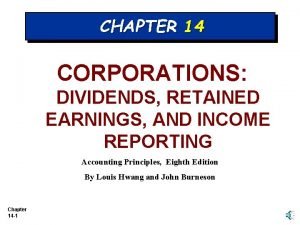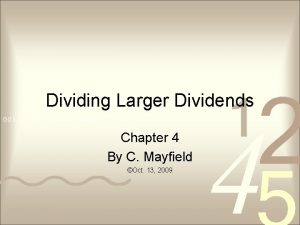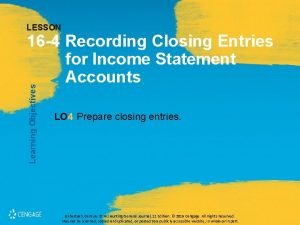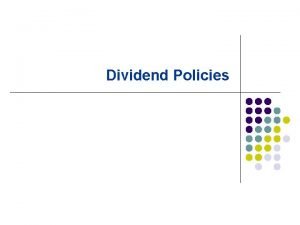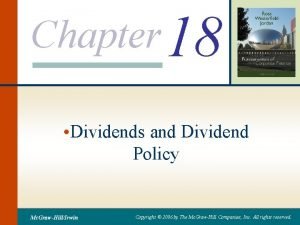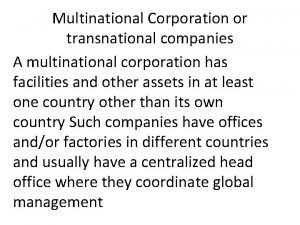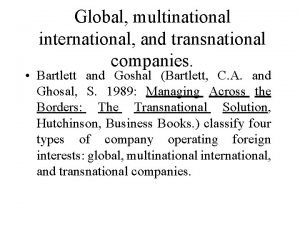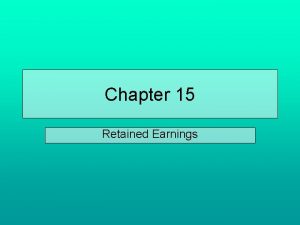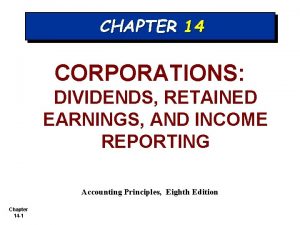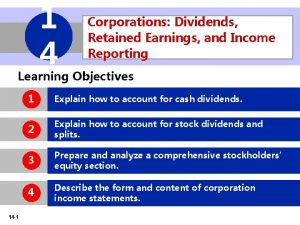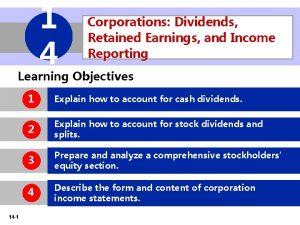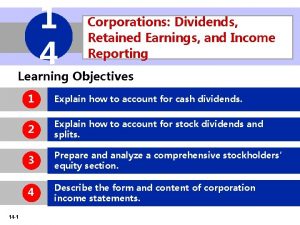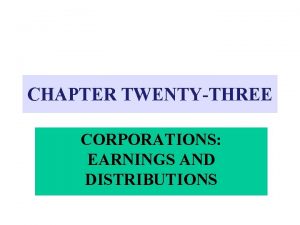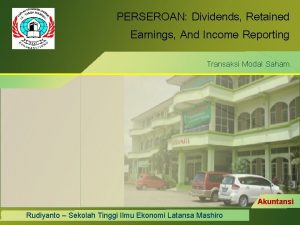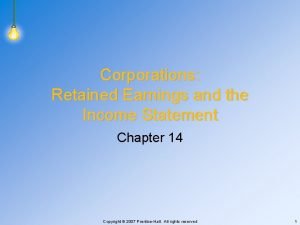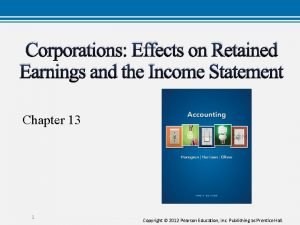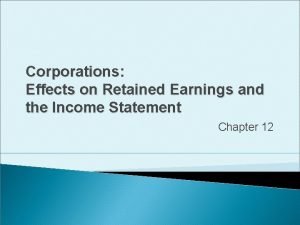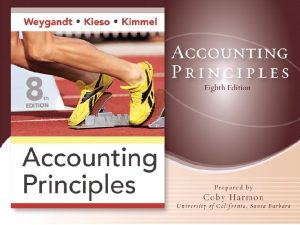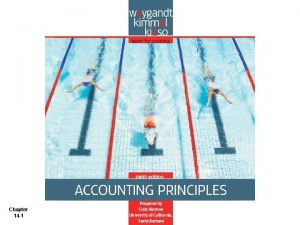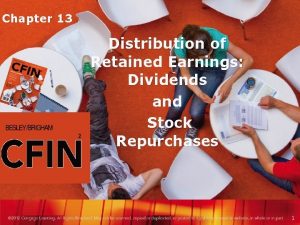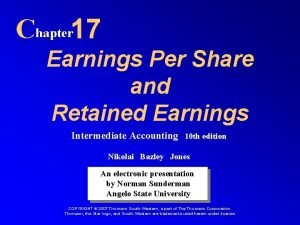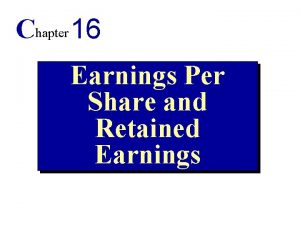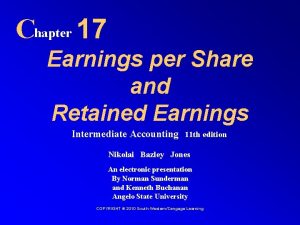Chapter 14 Corporations Dividends Retained Earnings and Income










































- Slides: 42

Chapter 14 Corporations: Dividends, Retained Earnings and Income Reporting Prepared by: Debbie Musil Kwantlen University College Weygandt, Kieso, Kimmel, Trenholm, Kinnear Accounting Principles, Third Canadian Edition © 2009 John Wiley & Sons Canada, Ltd.

Agenda Learning goals • Vocabulary • Weygandt, Kieso, Kimmel, Trenholm, Kinnear Accounting Principles, Third Canadian Edition © 2009 John Wiley & Sons Canada, Ltd.

Learning goals 1. 2. 3. 4. Prepare the entries for cash dividends, stock dividends, and stock splits, and compare their financial impact Prepare a corporate income statement Prepare a statement of retained earnings Evaluate earnings and dividends performance. Weygandt, Kieso, Kimmel, Trenholm, Kinnear Accounting Principles, Third Canadian Edition © 2009 John Wiley & Sons Canada, Ltd.

Vocabulary • • • Basic earnings per share • Cash dividend Change in accounting principle • • Comprehensive income statement • Correction of a prior period • error • Debt covenant • Declaration date • Dividend • Earnings per share (EPS) • Fully diluted earnings per share Interperiod tax allocation Intraperiod tax allocation Payment date Payout ratio Price-earning ratio (P/E) Record date Retained earnings restrictions Statement of retained earnings Stock dividend Stock split Weighted average number of shares Weygandt, Kieso, Kimmel, Trenholm, Kinnear Accounting Principles, Third Canadian Edition © 2009 John Wiley & Sons Canada, Ltd.

Cash Dividends Cash dividend distribution of cash to shareholders • To pay dividends, a corporation must: • • • Have enough retained earnings and cash Declare a dividend payable Declaration date: • Board of directors formally declares dividend • Commits company to a legal obligation • Declaration is recorded: Weygandt, Kieso, Kimmel, Trenholm, Kinnear Accounting Principles, Third Canadian Edition © 2009 John Wiley & Sons Canada, Ltd.

Cash Dividends 2 • Record date: • Ownership of shares is determined • Shareholders of record on this date will receive dividend • No journal entry required • Payment date: • Dividend is paid to shareholders and recorded: Weygandt, Kieso, Kimmel, Trenholm, Kinnear Accounting Principles, Third Canadian Edition © 2009 John Wiley & Sons Canada, Ltd.

Stock Dividends Cash dividend • Paid in cash • Decreases assets and shareholder’s equity Stock dividend Paid in shares • No change in assets or shareholders’ equity • Decreases R/E and increases share capital • • Doesn’t change your % ownership Weygandt, Kieso, Kimmel, Trenholm, Kinnear Accounting Principles, Third Canadian Edition © 2009 John Wiley & Sons Canada, Ltd.

Stock Dividends 2 Stock dividend neither increases nor decreases the assets in the company, investors are not receiving anything they did not already own. Weygandt, Kieso, Kimmel, Trenholm, Kinnear Accounting Principles, Third Canadian Edition © 2009 John Wiley & Sons Canada, Ltd.

Stock Dividends 2 Reasons for issuing stock dividends: • Satisfies shareholders' dividend expectations without spending cash • Decrease the price of shares making them more affordable • Emphasizes that a portion of shareholders’ equity has been permanently retained in the business • Therefore unavailable for cash dividends Weygandt, Kieso, Kimmel, Trenholm, Kinnear Accounting Principles, Third Canadian Edition © 2009 John Wiley & Sons Canada, Ltd.

Entries for Stock Dividends • Declaration date: • Issue (payment) date: Weygandt, Kieso, Kimmel, Trenholm, Kinnear Accounting Principles, Third Canadian Edition © 2009 John Wiley & Sons Canada, Ltd.

Equity Section after Stock Dividend Weygandt, Kieso, Kimmel, Trenholm, Kinnear Accounting Principles, Third Canadian Edition © 2009 John Wiley & Sons Canada, Ltd.

Stock Splits Involves the issue of additional shares to shareholders • Similar to a stock dividend • Increases the marketability of shares by lowering market value per share • Effect on share price is generally inversely proportional to size of split • Two – for – one stock split will decrease the stock price by 50% • Does not affect shareholders’ equity • Therefore no entries are required • Weygandt, Kieso, Kimmel, Trenholm, Kinnear Accounting Principles, Third Canadian Edition © 2009 John Wiley & Sons Canada, Ltd.

Stock Splits 2 Instead of a 10% stock dividend there was a two for one stock split Weygandt, Kieso, Kimmel, Trenholm, Kinnear Accounting Principles, Third Canadian Edition © 2009 John Wiley & Sons Canada, Ltd.

Comparison of Dividends and Stock Splits Cash dividends reduce assets and shareholders’ equity (retained earnings) • Stock dividends increase share capital and decrease retained earnings • Stock dividends have no effect (but do increase number of shares issued) • Weygandt, Kieso, Kimmel, Trenholm, Kinnear Accounting Principles, Third Canadian Edition © 2009 John Wiley & Sons Canada, Ltd.

Check for understanding • Sing CD Corporation has had five years of record earnings. Due to this success, the market price of its 500, 000 common shares tripled from $15 to $45 per share. During this period, the Common Shares account remained the same at $2 million. R/E increased from $1. 5 million to $10 million. President Bill Zerter is considering either ( a 10% stock dividend or (2) a two-for-one stock split. He asked you to show the before and after effects of each option on the accounts Common Shares and Retained Earnings and on the number of shares. (719) Weygandt, Kieso, Kimmel, Trenholm, Kinnear Accounting Principles, Third Canadian Edition © 2009 John Wiley & Sons Canada, Ltd.

Practice questions • • Self study 1 -3 Questions 1, 4 BE 14 -1 5 E 14 -1 2 Weygandt, Kieso, Kimmel, Trenholm, Kinnear Accounting Principles, Third Canadian Edition © 2009 John Wiley & Sons Canada, Ltd.

Corporate Income Taxes Income statement for corporations are the same as proprietorship or a partnership • Major difference is income taxes • • Since corporation is a separate legal entity • Affects income statement (income tax expense) and balance sheet (income tax payable) Weygandt, Kieso, Kimmel, Trenholm, Kinnear Accounting Principles, Third Canadian Edition © 2009 John Wiley & Sons Canada, Ltd.

Corporate Income Taxes 2 After a company determines its total income tax payable at year-end, it compares this amount to the total income tax instalments paid during the year. The difference between the income tax paid and income tax payable results in either an additional amount payable or a refund. Weygandt, Kieso, Kimmel, Trenholm, Kinnear Accounting Principles, Third Canadian Edition © 2009 John Wiley & Sons Canada, Ltd.

Corporate Income Taxes 3 Assume Leads had originally estimated that its taxable income would be $140, 000. It has a 30% income tax rate, so its income tax was anticipated to be $42, 000 ($140, 000*30%). Leads remitted monthly instalments in the amount of $3, 500 ($42, 000/12). At year end, Leads actually reports taxable income of $156, 000. Its total income tax liability is $46, 800, and not $42, 000 as estimated. Assuming it has already recorded and remitted $42, 000 of income tax, the required adjustment entry is for $4, 800 Dec. 31 Income Tax Expense Income Tax Payable 4, 800 Weygandt, Kieso, Kimmel, Trenholm, Kinnear Accounting Principles, Third Canadian Edition © 2009 John Wiley & Sons Canada, Ltd. 4, 800

Corporate Income Taxes 2 Interperiod tax allocation: Dividing income tax between amounts payable now and payable later • Intraperiod tax allocation: Associating income taxes in a period with their related items of income • Weygandt, Kieso, Kimmel, Trenholm, Kinnear Accounting Principles, Third Canadian Edition © 2009 John Wiley & Sons Canada, Ltd.

Comprehensive Income Statement Additional statement required in certain circumstances (R/E statement, income, balance sheet and cash flow statement) • An expansion of the subsection of the Equity section for other and Comprehensive Income • Includes all increases and decreases in shareholders’ equity except from share and dividend transactions • Weygandt, Kieso, Kimmel, Trenholm, Kinnear Accounting Principles, Third Canadian Edition © 2009 John Wiley & Sons Canada, Ltd.

Retained Earnings The cumulative total of income less losses and less declared dividends since incorporation • Represents part of shareholder’s claim on total assets of a corporation • • Not a claim on any specific asset (including cash) • It would not be smart for a company to pay dividend = R/E. But there are restrictions to limit that : • Contractual restrictions such as debt covenants • Voluntary restrictions imposed by the Board of Directors Weygandt, Kieso, Kimmel, Trenholm, Kinnear Accounting Principles, Third Canadian Edition © 2009 John Wiley & Sons Canada, Ltd.

Prior Period Adjustments • A prior period adjustment results from: • the correction of a material error in reporting net income in a prior year, or • the changing of an accounting principle • Accounting treatment: • Use corrected amount or new principle in reporting results for the current year • Disclose cumulative effect of correction/change as an adjustment to retained earnings, not on income statement • Correct/restate financial statements for prior periods • Disclose effect of change in financial statements Weygandt, Kieso, Kimmel, Trenholm, Kinnear Accounting Principles, Third Canadian Edition © 2009 John Wiley & Sons Canada, Ltd.

Correction of Prior Period Errors • Correction is made directly to retained earnings • Since effect of error is now located there (all revenues and expenses have been closed to retained earnings) Any corrections are net of any income tax effect • Example: overstatement of cost of goods sold • • Understatement of inventory, net income (now retained earnings), and income tax payable Weygandt, Kieso, Kimmel, Trenholm, Kinnear Accounting Principles, Third Canadian Edition © 2009 John Wiley & Sons Canada, Ltd.

Correction of Prior Period Errors Graber Inc, discovers in 2008 that is overstated its cost of goods sold in 2007 by $10, 000 as a results of errors in counting inventory. Because costs of goods sold was overstated income before income tax was understated by the same amount, $10, 000. If we assume an income tax rate of 30%, income tax expense would also be understated, but by $3, 000 ($10, 000*30%). The overall affect on net income is to understate it by $7, 000 ($10, 000 -$3, 000). In other words, net income is understated by the difference after tax [$10, 000 *(100%30%)]. If net income is understated, then R/E would also be understated by the same amount $7, 000 Weygandt, Kieso, Kimmel, Trenholm, Kinnear Accounting Principles, Third Canadian Edition © 2009 John Wiley & Sons Canada, Ltd.

Correction of Prior Period Errors Weygandt, Kieso, Kimmel, Trenholm, Kinnear Accounting Principles, Third Canadian Edition © 2009 John Wiley & Sons Canada, Ltd.

Change in Accounting Principle • Occurs when the principle used in current year is different that used in prior year • May be voluntary or prescribed (by the CICA) • Usually applied retroactively (prior years restated) unless not practical to do so Comparative amounts are restated • Retained earnings is adjusted, net of tax • • Similar to adjustment for correction of errors Weygandt, Kieso, Kimmel, Trenholm, Kinnear Accounting Principles, Third Canadian Edition © 2009 John Wiley & Sons Canada, Ltd.

Reporting of Prior Period Adjustments Reported in the statement of retained earnings • Adjustment is added to (subtracted from) opening balance of retained earnings, net of income tax effect • Financial statements of prior years are restated to reflect the change • Weygandt, Kieso, Kimmel, Trenholm, Kinnear Accounting Principles, Third Canadian Edition © 2009 John Wiley & Sons Canada, Ltd.

Reporting of Prior Period Adjustments Beginning of 2008 Graber changes from straight-line method of amortization for equipment to the decliningbalance method. The equipment was purchased on January 2, 2004. The cumulative effect of this change is to increase amortization expense and accumulated amortization by $24, 000 for the year of 2004 -2007 Amortization expense increase reduces net income reducing R/E Weygandt, Kieso, Kimmel, Trenholm, Kinnear Accounting Principles, Third Canadian Edition © 2009 John Wiley & Sons Canada, Ltd.

Reporting of Prior Period Adjustments Jan. 2 Income Tax Payable 7. 200 Retained Earnings 16, 800 Accumulated Amortization 24, 000 To record retroactive effect of change in amortization method Weygandt, Kieso, Kimmel, Trenholm, Kinnear Accounting Principles, Third Canadian Edition © 2009 John Wiley & Sons Canada, Ltd.

Sample Statement of Retained Earnings Weygandt, Kieso, Kimmel, Trenholm, Kinnear Accounting Principles, Third Canadian Edition © 2009 John Wiley & Sons Canada, Ltd.

Statement of Retained Earnings Shows the changes in retained earnings during the year • Transactions that affect retained earnings: • Weygandt, Kieso, Kimmel, Trenholm, Kinnear Accounting Principles, Third Canadian Edition © 2009 John Wiley & Sons Canada, Ltd.

Sample Statement of Retained Earnings Weygandt, Kieso, Kimmel, Trenholm, Kinnear Accounting Principles, Third Canadian Edition © 2009 John Wiley & Sons Canada, Ltd.

Check for understanding? Vega Corporation reported retained earnings of $5, 130, 000 at December 31, 2007. In 2008, the company earns $2, 000 of net income. It declares and pays a $250, 000 cash dividend. Vega also records a pre-tax adjustment of $275, 000 for an overstatement resulting from a mathematical error that affected 2007 ending inventory. The company also incurred a $25, 500 change to retained earnings for the reacquisition of common shares. Its income tax rate is 30%. Prepare a statement of retained earnings for the year ended December 31. (727) Weygandt, Kieso, Kimmel, Trenholm, Kinnear Accounting Principles, Third Canadian Edition © 2009 John Wiley & Sons Canada, Ltd.

Practice Questions • • Self-study 4+7 Question 7+9+11+13 BE 14 -6 10 E 14 -4 +6 Weygandt, Kieso, Kimmel, Trenholm, Kinnear Accounting Principles, Third Canadian Edition © 2009 John Wiley & Sons Canada, Ltd.

Earnings Performance: Earnings per Share Indicates net income earned by each common share • Reported on the income statement • Formula to calculate: • Net income less Preferred Dividends • ÷ Weighted Average Number of Common Shares = Earnings per Share Weighted average number of common shares = shares issued during the year x the fraction of the year they are outstanding • Example: April 1 = 3/12 months if calendar year used Weygandt, Kieso, Kimmel, Trenholm, Kinnear Accounting Principles, Third Canadian Edition © 2009 John Wiley & Sons Canada, Ltd.

Earnings Performance: Earnings per Share Assume that a company has 100, 000 common shares on January 1, and issued an additional 10, 000 shares on October 1. The weighted average number of share for the year would be calculated as follows: Weygandt, Kieso, Kimmel, Trenholm, Kinnear Accounting Principles, Third Canadian Edition © 2009 John Wiley & Sons Canada, Ltd.

Earnings per Share: Complex Share Structures • When a company has securities that can be converted into common shares • Example: convertible preferred shares • If converted, the additional common shares will result in a reduced (diluted) EPS figure • Two EPS amounts are calculated: • Basic EPS: as regular EPS formula from previous slide • Fully diluted EPS: calculated as if all securities were converted into common shares Weygandt, Kieso, Kimmel, Trenholm, Kinnear Accounting Principles, Third Canadian Edition © 2009 John Wiley & Sons Canada, Ltd.

Earnings Performance: Price-Earnings Ratio Helps investors compare earnings of different companies • Formula to calculate: • Market Price per Share ÷ Earnings per Share = Price-Earnings Ratio A high PE ratio is an indicator that investors believe the company has good earnings potential • P/E ratio of 34 means that the shares are trading 24 times it’s earnings. • Weygandt, Kieso, Kimmel, Trenholm, Kinnear Accounting Principles, Third Canadian Edition © 2009 John Wiley & Sons Canada, Ltd.

Payout Ratio Indicates what percentage of earnings a company is distributing to its shareholders • Can be calculated for both common and preferred shares: • Cash Dividends • • ÷ Net income = Payout Ratio Payout ratios vary with the industry High payout ratios can indicate that a company is not reinvesting enough in its operations Weygandt, Kieso, Kimmel, Trenholm, Kinnear Accounting Principles, Third Canadian Edition © 2009 John Wiley & Sons Canada, Ltd.

Check for understanding Shoten Limited reported net income of $249, 750 on its October 31, year-end income statement. The shareholders’ equity section of its balance sheet reported 3, 000 $2 -noncumulative preferred shares and 50, 000 common shares. Of the common shares, 40, 000 had been issued since the beginning of years, 15, 000 were issued on March 1, and 5, 000 were repurchased on August 1. The preferred dividend was declared and paid during the year. Calculate Shoten’s earnings per share. (731) Weygandt, Kieso, Kimmel, Trenholm, Kinnear Accounting Principles, Third Canadian Edition © 2009 John Wiley & Sons Canada, Ltd.

Practice Questions Self study questions 8 -10 • BE 14 -11 14 • E 14 -10+11 • Weygandt, Kieso, Kimmel, Trenholm, Kinnear Accounting Principles, Third Canadian Edition © 2009 John Wiley & Sons Canada, Ltd.
 Statement of retained earnings
Statement of retained earnings Advantage of retained profit
Advantage of retained profit Retained earnings ifrs
Retained earnings ifrs A restriction/appropriation of retained earnings
A restriction/appropriation of retained earnings Fundamental accounting equation
Fundamental accounting equation Retained earnings in accounting
Retained earnings in accounting Return on common stockholders’ equity
Return on common stockholders’ equity Par stock
Par stock Change in accounting principle retrospective
Change in accounting principle retrospective Retained earnings ifrs
Retained earnings ifrs Return on common stockholders’ equity
Return on common stockholders’ equity Bookkeeping is a mechanical task which involves
Bookkeeping is a mechanical task which involves Components of retained earnings
Components of retained earnings How to compute retained earnings
How to compute retained earnings Consolidated retained earnings
Consolidated retained earnings Cost of retained earnings
Cost of retained earnings Property dividend
Property dividend Single step income statement
Single step income statement The single step income statement emphasizes
The single step income statement emphasizes Retained earnings breakpoint formula
Retained earnings breakpoint formula Learnnowbiz
Learnnowbiz Corporate capital
Corporate capital Characteristics of corporation
Characteristics of corporation Chapter 6 corporations act
Chapter 6 corporations act Accounting for corporations chapter 13
Accounting for corporations chapter 13 Net profit after tax and preference dividends
Net profit after tax and preference dividends Corporations mergers and multinationals
Corporations mergers and multinationals Value added approach formula
Value added approach formula Tax payable
Tax payable Multi step statement of comprehensive income
Multi step statement of comprehensive income Accounting income vs taxable income
Accounting income vs taxable income Basic and diluted eps
Basic and diluted eps Private activity bond interest dividends
Private activity bond interest dividends Dividends of workplace diversity
Dividends of workplace diversity Dividend declaration date
Dividend declaration date Where is preferred dividends on financial statements
Where is preferred dividends on financial statements Journal entries for stock dividends
Journal entries for stock dividends How can i divide larger dividends
How can i divide larger dividends Record the closing entry for dividends
Record the closing entry for dividends Homemade dividend example
Homemade dividend example Compromise dividend policy
Compromise dividend policy Multinational vs transnational corporations
Multinational vs transnational corporations Multinational vs transnational
Multinational vs transnational
